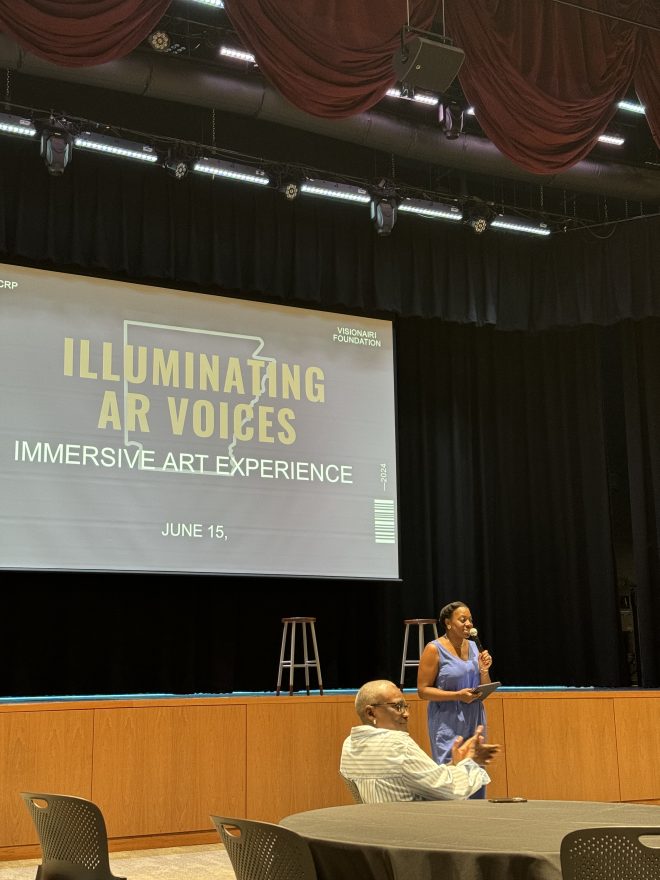Black voices illuminate immersive art exhibit

The Fayetteville Public Library hosted a digital Black history exhibit titled “Illuminating AR Voices” Saturday, June 15 at the Event Center.
The exhibition shares the stories of Black community members and their lives in Arkansas through a series of thought-provoking interviews. Interviewees included Nick Jones, Dorothy Marcy, Roy Stegall and Orson Weems.
Through the exhibit, attendees heard and saw Black community members narrating their richly diverse perspectives of their personal histories and their everyday experiences as Black Arkansans.
To accompany their stories, art and photos were placed beside each screen of the exhibit including quotes and short blurbs about their experiences.
Attendees were able to listen to the interviews on loop with a small receiver and a black wired earpiece to adjust the volume to their own preference as they viewed the exhibit.
Following the opening of the exhibit and refreshments, guests were welcomed to take a seat to view a video presentation about the inspiration and creation of the work introduced by KNWA’s Jaclyn House.
The video presentation introduced RoAnne Elliot of the Washington County Remembrance Project and Dr. Valandra, an associate professor in the School of Social Work with a joint appointment in the African and African American studies program in the Fulbright College at the University of Arkansas.
The two talked about their visit to The National Memorial for Peace and Justice in Montgomery, Alabama. The memorial is the first comprehensive place in the nation dedicated to the victims of racial terror lynchings. The two discovered that there were no recorded names for Arkansas’s Washington County and were inspired to begin furthering the record of those stories.
This led to the memorial of Aaron, Anthony and Randall who were three enslaved people who lost their lives to lynching in Washington County in 1856 after being falsey accused of murdering their enslaver. Today, there is a memorial for them here in Fayetteville, Arkansas.
The video presentation informed the audience of how the digital exhibit came to be inspired and presented with importance today. They spoke that Black stories are often distorted by whiteness and that Black lives in Arkansas have a need to be told by Black people themselves.
Speakers following the video presentation included Dr. Valandra and Dr. Airic Hughes for a community discussion on the importance of the project and Illuminating AR Voices.
A central theme to the project was talking about themselves in the context of their community or family, Valandra said.
“That was something that I thought was really impressive because at the same time, there were folks who were saying things like ‘I’ve lived here 33 years and I still feel like an outsider in some ways,’” she said.
There were major contrasts in their stories with the lack of a Black community in Northwest Arkansas, yet they were able to create their own community, she said.
The interviewees of the digital project made comparisons to their hometowns and how that was different to their experiences here.
The two year project coincides with some major changes in the state and the country legislatively, while also in relation to diversity, equity and inclusion. One of the major challenges came with people and companies pulling out of the project in fear and being more cautious because of the political climate silencing, Valandra said.
“There were some folks who agreed to be interviewed and then changed their minds. There were some folks who agreed to be interviewed and then decided they didn’t want to be interviewed on tape,” she said.
The panel also opened to the audience for questions in the “talk back” section of the discussion. Questions were asked regarding their personal inspiration for this work.
“This work often is out of necessity and survival,” Hughes said. “And for myself it’s purpose. It’s what I feel I’m put here to do.”
To learn more about the exhibit and view the video interviews, visit www.arblackvoices.com.





Comments